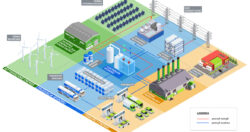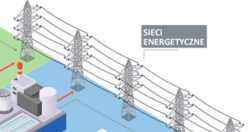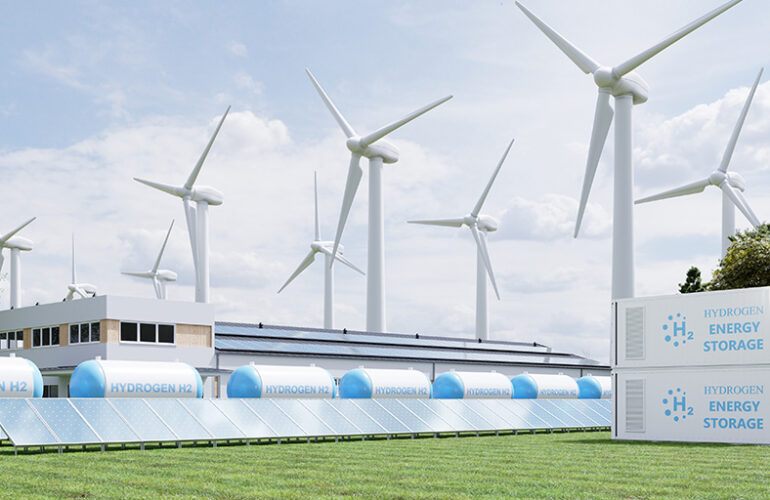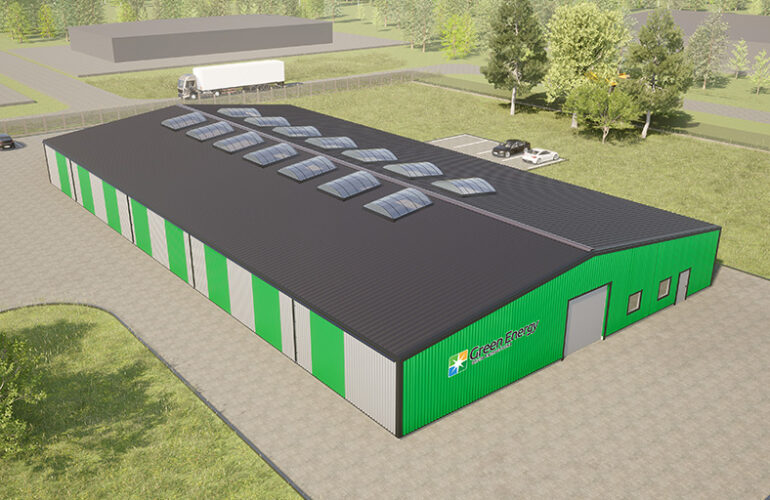HUB ENERGETYCZNY I WODOROWY
Pierwiastek wodoru jest najprostszym pierwiastkiem chemicznym w układzie okresowym pierwiastków. Ma on symbol H i liczbę atomową równą 1, co oznacza, że ma tylko jeden proton w jądrze atomowym. Jest to również najlżejszy ze wszystkich pierwiastków chemicznych. Wodór występuje w stanie gazowym przy temperaturze i ciśnieniu standardowym (0°C i 1 atm). Jest to również jedyny pierwiastek, który w normalnych warunkach atmosferycznych występuje jako gaz. Jest najlżejszym znanym pierwiastkiem i ma bardzo niską gęstość. Jest około 14 razy lżejszy od powietrza. Wodór jest bardzo reaktywny chemicznie. Tworzy on liczne związki chemiczne, w tym wodę (H2O) w reakcji z tlenem oraz związki organiczne w reakcjach z innymi pierwiastkami i związkami. Wodór z powodzeniem można wykorzystać w różnych sektorach działalności, ponieważ jest paliwem wysokoenergetycznym (33 kWh/kg), można wręcz stwierdzić, że jest dużym konkurentem dla technologii akumulatorowych.
W bezpośrednim zestawieniu wodoru z akumulatorami, gdzie ich gęstość energii waha się w granicach 250-260 Wh/kg, to wodór jako lider ma około 125 razy większą gęstość energetyczną na 1 kg. Wprowadzenie wodoru jako technologii, pozwoli na płynne zredukowanie emisyjności gospodarki. Państwa na wszystkich kontynentach podejmują ciągłe wysiłki w celu znalezienia nowych alternatyw dla rozwoju technologii neutralnych dla klimatu. Unia Europejska za cel postawiła sobie uzyskanie całkowitej neutralności klimatycznej do 2050 roku; wychwycenie i magazynowanie takiej samej ilości emisji gazów cieplarnianych, jaka zostanie uwolniona do atmosfery. Jest to jak najbardziej realny cel, biorąc pod uwagę fakt, jak szybko w dzisiejszym czasach następuje rozwój technologii, które jeśli są skuteczne i przynoszą odpowiednie rezultaty, wprowadzane są w życie w trybie natychmiastowym.
Zastosowanie wodoru znajdziemy w transporcie, przemyśle oraz energetyce. Wodór jest nośnikiem -energii, potrafi magazynować jej dużą ilość (33 kWh/kg), W miejscu, gdzie zawodzą technologie akumulatorowe, tj. w celu pokrycia długoterminowych niedoborów energii elektrycznej w systemie przesyłowym, wodór sprawdza się, jako idealna alternatywa. Wodór zmagazynowany w ten sposób, czy to w zbiornikach magazynowych, czy w systemie gazowym, można następnie przekształcić z powrotem w energię elektryczną w połączeniu z tlenem przy użyciu technologii ogniw paliwowych.
Wodór staje się bardzo optymistycznym rozwiązaniem problemów nowej polityki klimatycznej „New Green Deal” i pojawiających się coraz większych aspiracji używania tylko zielonej energii i eliminacji paliw kopalnych (całkowicie). Wodór może odegrać istotną rolę w nowej polityce energetycznej jako zielone i zrównoważone źródło energii, które przyczynia się do ograniczenia emisji gazów cieplarnianych, zróżnicowania źródeł energii i rozwoju nowoczesnych technologii.
Poniżej przedstawione jest kilka aspektów, w których wodór może być uwzględniony w nowej polityce energetycznej:
- Paliwo wodorowe: Wodór może być wykorzystywany jako paliwo wodorowe w ogniwach paliwowych, które generują energię elektryczną poprzez elektrochemiczne utlenianie wodoru. Ogniwa paliwowe są skuteczne, wydajne i produkują tylko czystą wodę jako produkt uboczny, co sprawia, że są przyjazne dla środowiska. Wdrażanie pojazdów wodorowych oraz infrastruktury do produkcji i dystrybucji wodoru może pomóc w ograniczeniu emisji CO2 w transporcie.
- Magazynowanie energii: Wodór może służyć jako nośnik energii, który umożliwia magazynowanie nadmiaru energii elektrycznej z odnawialnych źródeł, takich jak słoneczne i wiatrowe. Wodór może być wytwarzany podczas okresów nadmiaru energii i później wykorzystywany do produkcji energii elektrycznej w okresach niedoboru, co pomaga w zrównoważonym wykorzystaniu odnawialnych źródeł energii.
- Dekarbonizacja przemysłu: Wodór może być wykorzystywany w procesach przemysłowych, takich jak produkcja stali i amoniaku, aby zastąpić konwencjonalne źródła wodoru oparte na paliwach kopalnych. Ten „zielony” wodór może pomóc w ograniczeniu emisji CO2 z sektora przemysłowego.
- Transport publiczny: Wodór może być wykorzystywany w środkach transportu publicznego, takich jak autobusy, pociągi i taksówki wodorowe. Promowanie rozwoju i wdrażania tych pojazdów może przyczynić się do redukcji emisji w sektorze transportu.
- Badania i rozwój: Inwestycje w badania i rozwój związane z wodorem są kluczowe dla rozwijania nowych technologii produkcji, magazynowania i wykorzystania wodoru. Nowa polityka energetyczna może wspierać projekty badawcze i innowacje związane z wodorem.
Niskoemisyjny wodór będzie przydatny w świecie o niskiej emisji dwutlenku węgla, jako nośnik energii oraz, gdy zastosowania końcowe są zbyt trudne lub drogie do elektryfikacji. W związku z powyższym, wodór odgrywa kluczową rolę w modelowanych scenariuszach bezemisyjnej przyszłości.
Kraje planują ścieżki do zmniejszenia emisji gazów cieplarnianych netto, które opierają się na czystym wodorze, co prowadzi do rosnącego zainteresowania inwestycjami na całym świecie. Potencjalni producenci widzą w eksporcie czystego wodoru szansę gospodarczą. Potencjalni konsumenci dostrzegają korzyści płynące z dekarbonizacji i bezpieczeństwa energetycznego. Jednak globalnie zainteresowanie dopiero zaczyna przeradzać się w inwestycje.
Regionalne klastry innowacyjne, które zazwyczaj obejmują uniwersytety, laboratoria, parki badawcze, inkubatory i centra produkcyjne, od dawna wspierają wzrost gospodarczy, tworzenie miejsc pracy i konkurencyjność. Skoncentrowanie działalności innowacyjnej pod względem geograficznym, nawet we wspólnym ośrodku lub parku badawczym, może ułatwić współpracę i wymianę informacji między naukowcami, inżynierami i firmami. Dzięki odpowiednim zachętom, możliwe jest koordynowanie ich wysiłków badawczych tak, aby dzielili się drogim sprzętem i zapewniali uzupełniające zasoby.
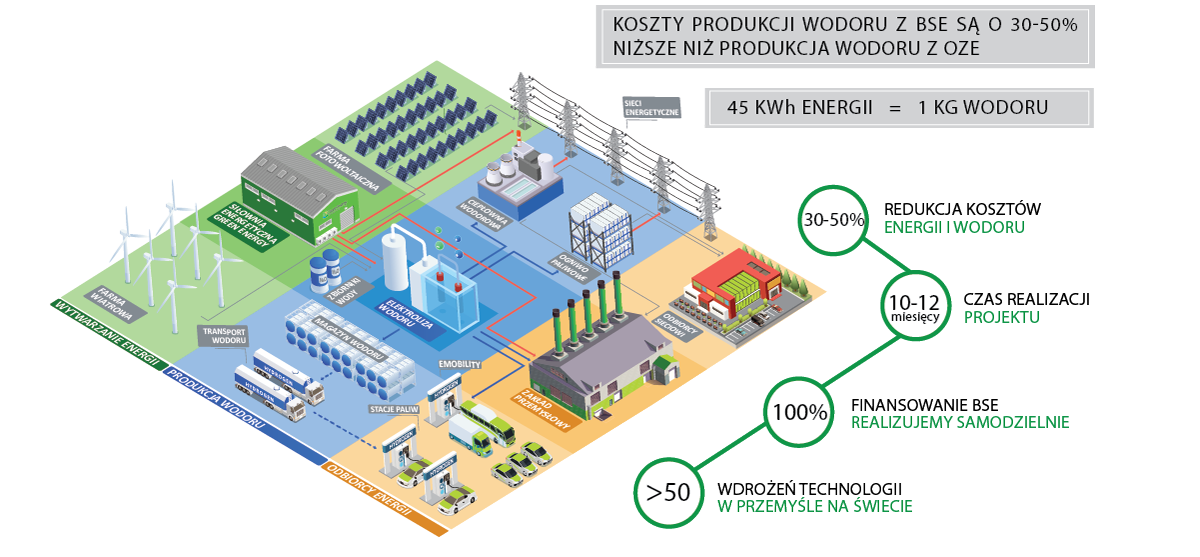
Hub wodorowy jest głównym użytkownikiem zielonego wodoru, który będzie wykorzystywał odnawialną energię elektryczną z sieci, w celu wytworzenia odpowiednich dostaw zielonego wodoru za pośrednictwem elektrolizera i przechowywał ten wodór w zbiornikach wysokociśnieniowych. Magazyn może mieć kilka funkcji:
- elektrolizer może być dobierany na podstawie średniego zapotrzebowania, a nie szczytowego,
- przechowywanie potencjalnie oddziela produkcję i użytkowanie, aby umożliwić elektrolizerowi korzystanie z najtańszej odnawialnej energii elektrycznej dla tych pierwszych, gdy jest ona dostępna,
- zmagazynowany wodór może być wykorzystany jako zapasowy, w przypadku przerwy w dostawie prądu.
Elektrolizer, przechowywanie i podstawowe zastosowanie będą musiały zostać zoptymalizowane pod kątem najbardziej korzystnym ekonomicznie.
Oprócz zaspokojenia podstawowego zastosowania głównego użytkownika, koncentrator wodorowy może dostarczać wodór do zastosowań pobliskich, mniejszych użytkowników i czerpać z tego zyski.
Hub wodorowy to ogół infrastruktury potrzebnej do produkcji wodoru. W jego skład wchodzą:
- instalacja do produkcji wodoru – elektrolizery,
- infrastruktura logistyczna,
- infrastruktura dystrybucyjna.
Wielkość i rodzaj instalacji wchodzących w skład hub-ów uzależniony jest od tego, z czego pozyskiwany jest wodór.

